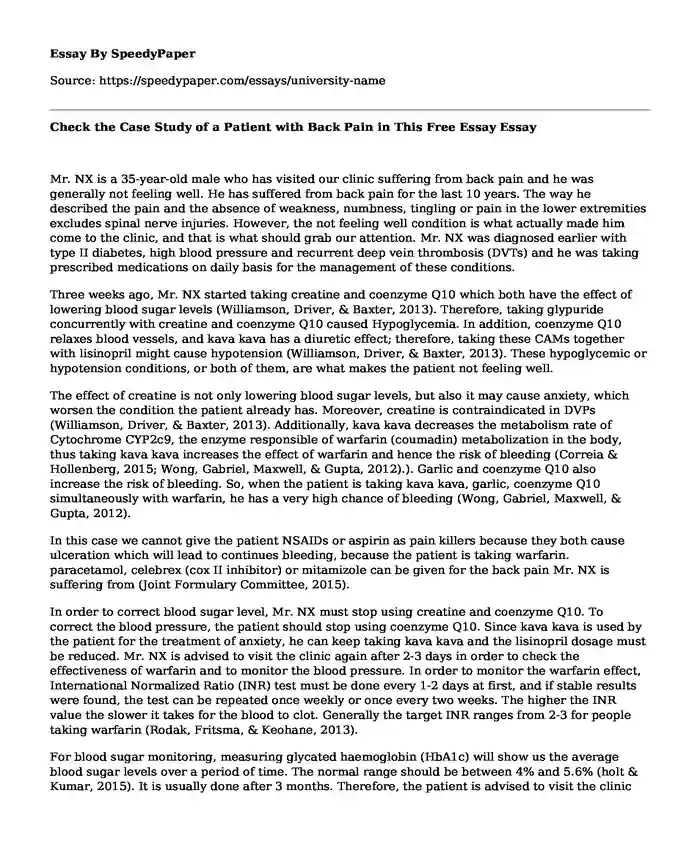
| Type of paper: | Essay |
| Categories: | Health and Social Care Medicine |
| Pages: | 3 |
| Wordcount: | 719 words |
Mr. NX is a 35-year-old male who has visited our clinic suffering from back pain and he was generally not feeling well. He has suffered from back pain for the last 10 years. The way he described the pain and the absence of weakness, numbness, tingling or pain in the lower extremities excludes spinal nerve injuries. However, the not feeling well condition is what actually made him come to the clinic, and that is what should grab our attention. Mr. NX was diagnosed earlier with type II diabetes, high blood pressure and recurrent deep vein thrombosis (DVTs) and he was taking prescribed medications on daily basis for the management of these conditions.
Three weeks ago, Mr. NX started taking creatine and coenzyme Q10 which both have the effect of lowering blood sugar levels (Williamson, Driver, & Baxter, 2013). Therefore, taking glypuride concurrently with creatine and coenzyme Q10 caused Hypoglycemia. In addition, coenzyme Q10 relaxes blood vessels, and kava kava has a diuretic effect; therefore, taking these CAMs together with lisinopril might cause hypotension (Williamson, Driver, & Baxter, 2013). These hypoglycemic or hypotension conditions, or both of them, are what makes the patient not feeling well.
The effect of creatine is not only lowering blood sugar levels, but also it may cause anxiety, which worsen the condition the patient already has. Moreover, creatine is contraindicated in DVPs (Williamson, Driver, & Baxter, 2013). Additionally, kava kava decreases the metabolism rate of Cytochrome CYP2c9, the enzyme responsible of warfarin (coumadin) metabolization in the body, thus taking kava kava increases the effect of warfarin and hence the risk of bleeding (Correia & Hollenberg, 2015; Wong, Gabriel, Maxwell, & Gupta, 2012).). Garlic and coenzyme Q10 also increase the risk of bleeding. So, when the patient is taking kava kava, garlic, coenzyme Q10 simultaneously with warfarin, he has a very high chance of bleeding (Wong, Gabriel, Maxwell, & Gupta, 2012).
In this case we cannot give the patient NSAIDs or aspirin as pain killers because they both cause ulceration which will lead to continues bleeding, because the patient is taking warfarin. paracetamol, celebrex (cox II inhibitor) or mitamizole can be given for the back pain Mr. NX is suffering from (Joint Formulary Committee, 2015).
In order to correct blood sugar level, Mr. NX must stop using creatine and coenzyme Q10. To correct the blood pressure, the patient should stop using coenzyme Q10. Since kava kava is used by the patient for the treatment of anxiety, he can keep taking kava kava and the lisinopril dosage must be reduced. Mr. NX is advised to visit the clinic again after 2-3 days in order to check the effectiveness of warfarin and to monitor the blood pressure. In order to monitor the warfarin effect, International Normalized Ratio (INR) test must be done every 1-2 days at first, and if stable results were found, the test can be repeated once weekly or once every two weeks. The higher the INR value the slower it takes for the blood to clot. Generally the target INR ranges from 2-3 for people taking warfarin (Rodak, Fritsma, & Keohane, 2013).
For blood sugar monitoring, measuring glycated haemoglobin (HbA1c) will show us the average blood sugar levels over a period of time. The normal range should be between 4% and 5.6% (holt & Kumar, 2015). It is usually done after 3 months. Therefore, the patient is advised to visit the clinic after three months to check the blood sugar levels. Blood pressure should be monitored daily at home or every few days in the hospital. Normal blood pressure is around 120/80 mm Hg.
REFERENCES
Correia, M.A., Hollenberg, B.F. (2015) Inhibition of Cytochrome P450 Enzymes. In R.O.M Paul (Ed.), Cytochrome P450 (pp. 177-259). Geneve, Switzerland: Springer.
Holt, T., Kumar, S. (2015). ABC of Diabetes (7th ed.). West Succex, UK: Wiley.
Joint Formulary Committee. (2015) British National Formulary (BNF) 69. East Smithfield, London: Pharmaceutical Press.
Rodak, B.F., Fritsma, G.A., & Keohane, E. (2013) Hematology: Clinical Principles and Applications (4th ed.). St.Louise, Missourti: Elsevier.
Williamson, E.M., Driver, S., Baxter, K. (2013) Stockley's Herbal Medicines Interactions: A Guide to the Interactions of Herbal Medicines (2nd ed.). East Smithfield, London: Pharmaceutical Press.
Wong, W.W., Gabriel, A., Maxwell, G.P., Gupta, S.C. (2012). Bleeding Risks of Herbal, Homeopathic, and Dietary Supplements: A Hidden Nightmare for Plastic Surgeons? Aesthetic Surgery Journal, 332-346. DOI: http://dx.doi.org/10.1177/1090820X12438913.
Cite this page
Check the Case Study of a Patient with Back Pain in This Free Essay. (2020, Nov 26). Retrieved from https://speedypaper.net/essays/university-name
Request Removal
If you are the original author of this essay and no longer wish to have it published on the SpeedyPaper website, please click below to request its removal:
- Healthy lifestyle
- Free Essay with a Critique of the Media Effects Model
- Essay Sample Dedicated to the Syrian Refugee Crisis
- Free Essay Sample with Facebook Strategy Recommendation
- Essay Example on Effective Billing and Management of Revenues
- Free Essay: The Effects of Methylphenidate on Female and Male Fertility
- Paper Example. Online Learning is Less Satisfactory than Face-To-Face
Popular categories




